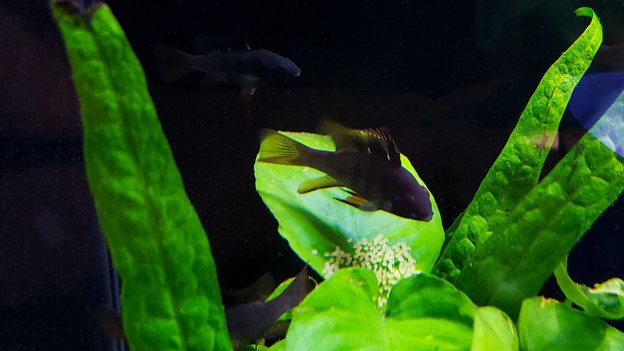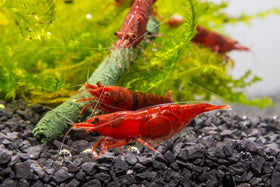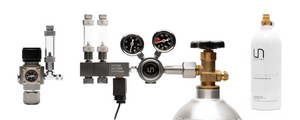
Top 5 Aquarium Plants for Your Breeding Tank
Written by: Tammy (@aquarist_tl) and Team Buce Plant
When it comes to tanks set up specifically for breeding, they will look a lot different than the typical aquascaped display aquariums that many aquarists strive for. Some may even have nothing but the fish themselves! This is largely because one of the goals for the design of breedings tanks is to be as easy to maintain as possible. It is much easier to keep a bare-bottom, mostly empty aquarium clean because you can see all the detritus that needs to be removed. In a tank with substrate and decorations, waste is likely to build up without us knowing. The debris tends to fall between the cracks within the substrate and under the decorations.
For breeders, the health of the fish is placed before the aesthetics of the aquarium. However, there is one thing that can be added into these tanks to help both the fish and the overall appeal of the tank: aquatic plants! Plants can help keep the water clean, provide visual barriers for the fish, and add a more natural look to the breeding aquariums. Personally, I try to add plants into every aquarium I set up. Here are the top 5 aquatic plants that I would recommend to anyone trying to breed fish:
1. Indian Fern / Water Sprite (Ceratopteris Siliquosa)

Young guppy fry like to stay near the Water Sprite to be able to get away from predators
Ceratopteris Siliquosa is an amazing plant for breeding setups. I received it once by accident and tossed it into one of my grow-out tanks. I let it float at the top of the water where it soon took off, and covered the entire surface of the aquarium. One of the best traits of this plant is that it grows very fast without the help of any fertilizers, and fast growth means it’s removing a lot of nitrates that have built up in the aquarium. It’s great to have in tanks as a safety measure against excessive nitrate buildup, making it perfect for grow-out aquariums where many fish are being kept and fed in large quantities.
Once I deemed the Indian Fern had grown to the point where it was taking up too much space, I trimmed off large portions to distribute to other tanks. One of the aquariums I put it in was a breeding tank for guppies. After a while, when the fern had grown out more, I noticed that the guppy population in that aquarium had exploded. I looked at the surface of the water to see that this plant provided a lot of protection for the tiny guppy fry to hide amongst, away from the eager mouths of the older fish. They were able to stay between the leaves at the top of the water, where the larger fish were unable to reach.

Overall, the Indian Fern is easy to grow, maintain, and propagate. All it really needs is a strong enough light to keep it happy.
2. Hornwort (Ceratophyllum Demersum)

Hornwort is a very popular aquatic plant in the aquarium hobby. It is commonly found in local fish stores and it’s success is likely due to its hardiness. Hornwort can tolerate many different water parameters, even brackish water! Similar to the Indian Fern, Hornwort can be used as a floating plant or it can be placed into substrate. It is a fast growing plant that is easy to care for. Many aquarists float it at the top of their tanks to reduce nitrates. This would be especially handy in breeding setups where the water should be kept as pristine as possible.
Since hornwort is a stem plant, it is super easy to propagate. Just trim a few stems once they're too long and those trimmings will become their own plantlings. Hornwort’s many bushes of thin bristles provide safe places for young fry to hang out. They can safely live among the leaves of the hornwort until they grow big enough to safely venture out into other parts of the tank.
3. Moss

Moss is one of the best plants to have for breeding fish and shrimp. It is a fairly common plant that comes in many different species. A few of the more popular ones seen being used in breeding tanks are Java Moss, Christmas Moss, and Subwassertang. Mosses like these are very easy to care for. They don’t require high lighting or fertilizers to do well. Some are even kept in tanks with no designated lighting for the aquarium, and they are still able to grow. Although moss is considered a slow-grower, it shouldn’t be too long before it’s covering the bottom of the tank.

Even grown fish like this electric blue ram can use moss to hide from aggressive tank-mates
Moss is a very versatile plant, which is why some breeders deem it is essential to have it in order to thrive in the world of breeding. A big reason moss is such an excellent addition to breeding setups is because it provides so much more surface area within the aquarium. Dense piles of moss are great hideouts for small fish fry and baby shrimplets. Each strand of moss can also contain biofilm for shrimp to snack on. When breeding fish that scatter eggs, moss would be very helpful since these types of fish tend to spread the eggs into areas where the eggs will be hidden, making moss a great candidate to house the eggs. Moss also helps lessen the nitrate buildup a bit, keeping the water cleaner.
4. Water Lettuce (Pistia Stratiotes)

Any type of floating plant is welcomed in breeding setups because of their exceptional ability to absorb nitrates out of the aquarium water. What makes water lettuce in particular special is its bigger size and especially long roots. Water lettuce itself can grow up to 10 inches in diameter, while the roots can reach a height of about 12 inches. However, it is rare for these floaters to grow this large in the home aquarium.
Instead of continuing the growth of one plant, the conditions of a typical aquarium usually lead watter lettuce to constantly propagate. You would see more and more plantlings form, each one only about an inch or two in diameter. This size makes the aquarium plant easier to maintain than some of the other types of floating plants, because you would only need to take out a few when there’s too many covering the surface of the tank. Its long roots also create a maze-like environment for young fish fry to dart through to hide from potential threats.
Like other floating plants, water lettuce prefers to be in still water. It will not do well in a tank with a strong current. An aquarium with little to no flow would be ideal for them, as long as they are not repeatedly getting pushed underwater. Water lettuce has also been said to do a lot better in humid environments, so adding a lid on the tank that they’re in may help if you see them struggling.
5. Anubias

Philippine Blue Angelfish spawning on the leaf of an Anubias Barteri
You can never go wrong with Anubias! It’s one of the hardiest plants in the hobby, making it ideal for new aquarists. It does well in tanks with dim lighting, and is actually named after the Egyptian god of the afterlife Anubis because of its preference for darker areas. Anubias comes in many shapes, colors, and sizes. Some of the more common species of Anubias are Anubias Nana Petite, Anubias Nana, and Anubias Barteri. A great thing about Anubias is that it is an epiphyte plant, so it does not need to be buried in substrate to do well. It can be left floating in the tank, stuffed into cracks between rocks, or glued to driftwood in the aquarium. Burying it may actually harm the plant by causing its rhizome to rot.

Black rams guarding their batch of eggs that they laid on an Anubias leaf
Like the other plants listed in this blog post, Anubias helps fish by providing safe places to hide. Unfortunately, its slow growth may not help reduce nitrates by much. However, the smooth and broad leaves of Anubias can be the perfect place for fish to lay their eggs on! Egg-laying fish often prefer to lay their eggs on objects rather than the tank walls or floor. Having Anubias in the aquarium would give them more options on where to begin their breeding process.
Plants are such a great thing to have in aquariums because they provide many benefits to the tanks’ inhabitants. The strategy I’ve started to use is to incorporate all or most of these plants into one tank. That way, there’s always cover on both the top and bottom of the aquarium for fish to feel safe and to keep young fry away from eager mouths. I hope this blog post was able to help out anyone interested in breeding fish!
Tell us - Was this article helpful? Please comment your thoughts!
If you have any questions regarding this article, please DM us on Instagram or Facebook so we can assist you! @buceplant





Comments
Leave a comment